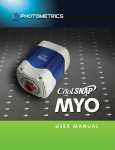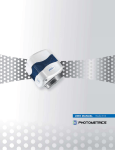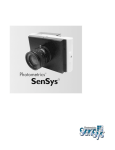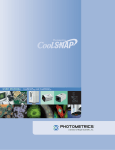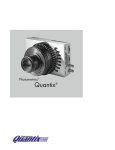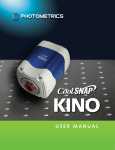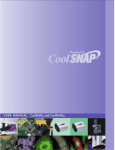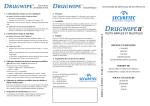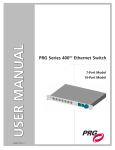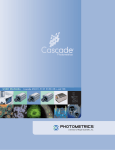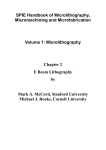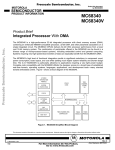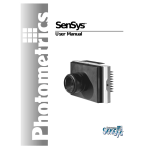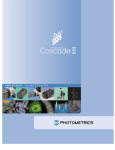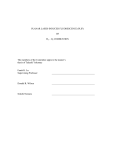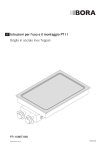Download CoolSNAP HQ2 User Manual
Transcript
User Manual for CoolSNAPHQ2 and CoolSNAPK4
Systems
57-063-001 Rev D0
© Copyright 2003-2005
Photometrics
3440 East Britannia Drive
Tucson, Arizona 85706
Tel: 520.889.9933
Fax: 520.295.0299
All rights reserved. No part of this publication may be reproduced by any means without the written
permission of Photometrics, a division of Roper Scientific, Inc.
Printed in the United States of America.
CoolSNAP and RS Image are trademarks and Photometrics, PVCAM, and Roper Scientific are registered
trademarks of Roper Scientific, Inc.
Linux is a registered trademark of Linus Torvalds.
Mac, Macintosh, Mac OS, and Panther are trademarks of Apple Computer, Inc., registered in the U.S. and
other countries.
Pentium is a registered trademark of Intel Corporation.
Windows is a registered trademark of Microsoft Corporation in the United States and/or other countries.
Other brand and product names are the trademarks or registered trademarks of their respective owners and
manufacturers.
The information in this publication is believed to be accurate as of the publication release date. However,
Photometrics does not assume any responsibility for any consequences including any damages resulting from
the use thereof. The information contained herein is subject to change without notice. Revision of this
publication may be issued to incorporate such change.
57-063-001 Rev D0
LIMITED WARRANTY
Photometrics, a division of Roper Scientific, Inc., (“Photometrics,” us,” “we,” “our”) makes the following
limited warranties. These limited warranties extend to the original purchaser (“You”, “you”) only and no
other purchaser or transferee. We have complete control over all warranties and may alter or terminate any or
all warranties at any time we deem necessary.
Basic Limited One (1) Year Warranty
Photometrics warrants this product against substantial defects in materials and / or workmanship for a period
of up to one (1) year after shipment. During this period, Photometrics will repair the product or, at its sole
option, repair or replace any defective part without charge to you. You must deliver the entire product to the
Photometrics factory or, at our option, to a factory-authorized service center. You are responsible for the
shipping costs to return the product. International customers should contact their local Photometrics
authorized representative/distributor for repair information and assistance, or visit our technical support
page at www.photomet.com.
Limited One (1) Year Warranty on Refurbished or Discontinued Products
Photometrics warrants, with the exception of the CCD imaging device (which carries NO WARRANTIES
EXPRESS OR IMPLIED), this product against defects in materials or workmanship for a period of up to one
(1) year after shipment. During this period, Photometrics will repair or replace, at its sole option, any defective
parts, without charge to you. You must deliver the entire product to the Photometrics factory or, at our option,
a factory-authorized service center. You are responsible for the shipping costs to return the product to
Photometrics. International customers should contact their local Photometrics representative/distributor for
repair information and assistance or visit our technical support page at www.photomet.com.
Normal Wear Item Disclaimer
Photometrics does not warrant certain items against defect due to normal wear and tear. These items include
internal and external shutters, cables, and connectors. These items carry no warranty, expressed or implied.
Sealed Chamber Integrity Limited 24 Month Warranty
Photometrics warrants the sealed chamber integrity of all our products for a period of twenty-four (24)
months after shipment. If, at anytime within twenty-four (24) months from the date of delivery, the detector
should experience a sealed chamber failure, all parts and labor needed to restore the chamber seal will be
covered by us. Open chamber products carry NO WARRANTY TO THE CCD IMAGING DEVICE, EXPRESSED
OR IMPLIED. Responsibility for shipping charges is as described above under our Basic Limited One (1) Year
Warranty.
Vacuum Integrity Limited 24 Month Warranty
Photometrics warrants the vacuum integrity of all our products for a period of up to twenty-four (24) months
from the date of shipment. We warrant that the detector head will maintain the factory-set operating
temperature without the requirement for customer pumping. Should the detector experience a Vacuum
Integrity failure at anytime within twenty-four (24) months from the date of delivery all parts and labor
needed to restore the vacuum integrity will be covered by us. Responsibility for shipping charges is as
described above under our Basic Limited One (1) Year Warranty.
Software Limited Warranty
Photometrics warrants all of our manufactured software discs to be free from substantial defects in materials
and / or workmanship under normal use for a period of one (1) year from shipment. Photometrics does not
warrant that the function of the software will meet your requirements or that operation will be uninterrupted
or error free. You assume responsibility for selecting the software to achieve your intended results and for the
use and results obtained from the software. In addition, during the one (1) year limited warranty. The original
purchaser is entitled to receive free version upgrades. Version upgrades supplied free of charge will be in the
form of a download from the Internet. Those customers who do not have access to the Internet may obtain the
version upgrades on a CD-ROM from our factory for an incidental shipping and handling charge. See Item 12
in the following section of this warranty ("Your Responsibility") for more information.
Owner's Manual and Troubleshooting
You should read the owner’s manual thoroughly before operating this product. In the unlikely event that you
should encounter difficulty operating this product, the owner’s manual should be consulted before contacting
the Photometrics technical support staff or authorized service representative for assistance. If you have
consulted the owner's manual and the problem still persists, please contact the Photometrics technical support
staff or our authorized service representative. See Item 12 in the following section of this warranty ("Your
Responsibility") for more information.
iv
Your Responsibility
The above Limited Warranties are subject to the following terms and conditions:
1.
You must retain your bill of sale (invoice) and present it upon request for service and repairs or
provide other proof of purchase satisfactory to Photometrics.
2.
You must notify the Photometrics factory service center within (30) days after you have taken
delivery of a product or part that you believe to be defective. With the exception of customers who
claim a “technical issue” with the operation of the product or part, all invoices must be paid in full in
accordance with the terms of sale. Failure to pay invoices when due may result in the interruption
and/or cancellation of your one (1) year limited warranty and/or any other warranty, expressed or
implied.
3.
All warranty service must be made by the Photometrics factory or, at our option, an authorized
service center.
4.
Before products or parts can be returned for service you must contact the Photometrics factory and
receive a return authorization number (RMA). Products or parts returned for service without a return
authorization evidenced by an RMA will be sent back freight collect.
5.
These warranties are effective only if purchased from the Photometrics factory or one of our
authorized manufacturer's representatives or distributors.
6.
Unless specified in the original purchase agreement, Photometrics is not responsible for installation,
setup, or disassembly at the customer’s location.
7.
Warranties extend only to defects in materials or workmanship as limited above and do not extend to
any product or part which has:
•
been lost or discarded by you;
•
been damaged as a result of misuse, improper installation, faulty or inadequate maintenance or
failure to follow instructions furnished by us;
•
had serial numbers removed, altered, defaced, or rendered illegible;
•
been subjected to improper or unauthorized repair; or
•
been damaged due to fire, flood, radiation, or other “acts of God” or other contingencies beyond
the control of Photometrics.
8.
After the warranty period has expired, you may contact the Photometrics factory or a Photometricsauthorized representative for repair information and/or extended warranty plans.
9.
Physically damaged units or units that have been modified are not acceptable for repair in or out of
warranty and will be returned as received.
10. All warranties implied by state law or non-U.S. laws, including the implied warranties of merchantability
and fitness for a particular purpose, are expressly limited to the duration of the limited warranties set forth
above. With the exception of any warranties implied by state law or non-U.S. laws, as hereby limited, the
forgoing warranty is exclusive and in lieu of all other warranties, guarantees, agreements, and similar
obligations of manufacturer or seller with respect to the repair or replacement of any parts. In no event
shall Photometrics’ liability exceed the cost of the repair or replacement of the defective product or part.
11. This limited warranty gives you specific legal rights and you may also have other rights that may vary
from state to state and from country to country. Some states and countries do not allow limitations on
how long an implied warranty lasts, when an action may be brought, or the exclusion or limitation of
incidental or consequential damages, so the above provisions may not apply to you.
12. When contacting us for technical support or service assistance, please refer to the Photometrics factory
of purchase, contact your authorized Photometrics representative or reseller, or visit our technical
support page at www.photomet.com.
v
U. S. Government Restricted Rights
The software and documentation are provided with Restricted Rights. Use, duplication, or disclosure by the
Government is subject to restrictions as set forth in subparagraph (c)(1)(ii) of the Rights in Technical Data and
Computer Software clause at DFARS 252.227-7013 or subparagraphs (c)(1) and (2) of the Commercial
Computer Software-Restricted Rights at 48 CFR 52.227-19, as applicable. Contractor/manufacturer is
Photometrics, 3440 East Britannia Drive, Tucson, AZ 85706.
This license is effective until terminated. It will terminate upon the conditions set forth above or if you fail to
comply with any term hereof. Upon termination, you agree that the software and accompanying materials,
and all copies thereof, will be destroyed. This agreement is governed by the laws of the State of Arizona. You
acknowledge that you have read this agreement, you understand it, you agree to be bound by its terms, and
that this is the complete and exclusive statement of the agreement between you and Photometrics regarding
the software.
vi
CoolSNAPHQ /CoolSNAPK4 User Manual
2
vii
viii
CoolSNAPHQ /CoolSNAPK4 User Manual
2
Table of Contents
Chapter 1. Introduction
Description ....................................................................................................................................... 1
System Components....................................................................................................................... 1
About This Manual......................................................................................................................... 2
Precautions....................................................................................................................................... 2
Environmental Requirements....................................................................................................... 3
Storage Requirements .................................................................................................................... 3
Microscopes, Lenses, and Tripods............................................................................................... 3
Repairs .............................................................................................................................................. 3
Cleaning............................................................................................................................................ 3
Photometrics Customer Service ................................................................................................... 4
Chapter 2. System Installation
Introduction ..................................................................................................................................... 5
Software Compatibility Requirements ....................................................................................... 5
Host Computer Requirements...................................................................................................... 5
Multiple Cameras............................................................................................................................ 6
Software Installation....................................................................................................................... 6
Installing the PCICard................................................................................................................... 6
Connecting Your CoolSNAP Camera ......................................................................................... 7
Chapter 3. Operating Features
Dual-Mode Operation (CoolSNAP HQ2 Only) ........................................................................... 9
Normal mode ........................................................................................................................... 9
Alternate Normal mode ....................................................................................................... 10
Antiblooming ......................................................................................................................... 10
Triggered Operation..................................................................................................................... 10
Trigger-first mode ................................................................................................................. 11
Strobe mode............................................................................................................................ 11
Bulb mode............................................................................................................................... 11
CoolSNAP HQ2 Application Examples ...................................................................................... 12
Example 1................................................................................................................................ 12
Example 2................................................................................................................................ 12
Example 3................................................................................................................................ 12
Chapter 4. Troubleshooting
System Does Not Boot Normally ............................................................................................... 13
New Hardware Found Dialog Box Does Not Appear (Windows 2000/XP) ....................... 13
Images Not Displayed.................................................................................................................. 13
Bright Spots in Image / Increased Background Noise............................................................... 14
Camera Running Too Warm....................................................................................................... 14
PVCAM Error Message Appears ............................................................................................... 14
Lengthy Pauses During Imaging ............................................................................................... 14
ix
Chapter 5. Basic Specifications
Camera Dimensions (Front) ........................................................................................................15
Camera Dimensions (Bottom).....................................................................................................16
Focal Plane Measurement............................................................................................................17
Additional Measurements ...........................................................................................................18
CCD Specifications and Orientation..........................................................................................18
Connectors......................................................................................................................................19
POWER Connector Pinout...................................................................................................19
I/O Connector Pinout...........................................................................................................20
Power Supply Specifications and Dimensions ........................................................................22
Figures
Figure 1.
Figure 2.
Figure 3.
Figure 4.
Figure 5.
Figure 6.
x
Normal Mode, Overlapped .........................................................................................9
Normal Mode, Nonoverlapped ..................................................................................9
QE for Normal and Alternate Normal Modes.......................................................10
Trigger-First Mode Timing Diagram.......................................................................11
Strobe Mode Timing Diagram ..................................................................................11
Bulb Mode Timing Diagram .....................................................................................11
CoolSNAPHQ /CoolSNAPK4 User Manual
2
Chapter 1.
Introduction
Description
The Photometrics® CoolSNAPHQ2 and CoolSNAPK4, from Roper Scientific®,
are industry-leading cameras for low-light fluorescence microscopy. These
cameras incorporate progressive-scan CCDs (charge-coupled devices), a 12or 14-bit digitizer, and low-noise electronics to produce monochrome
images at greater than 1k x 1k resolution.
System
Components
In addition to the components shown below, the CoolSNAP™ package also
includes RS Image™ software.
Camera (with Test Lens) and DATA Cable
CoolSNAP IEEE-1394 Cable
CoolSNAP IEEE-1394 Interface Card
CoolSNAP LVDS Cable
CoolSNAP LVDS Interface Card
Power Supply with Power Cable and Power Cord
1
About This
Manual
The CoolSNAP User Manual is divided into five chapters. It is suggested that you
read the entire manual before operating the camera in order to ensure proper
use. The chapters that follow this introduction are
•
System Installation — Instructions for connecting your CoolSNAP
camera to your computer via the CoolSNAP PCI card.
•
Operating Features — Discusses CoolSNAP features such as
antiblooming, trigger modes, and (for the CoolSNAPHQ2) the dual-speed
ADC.
•
Troubleshooting — Provides answers to camera system problems.
•
Basic Specifications — Provides specifications for CoolSNAP system
components.
Note: Unless otherwise noted, the CoolSNAPHQ2 and the CoolSNAPK4 cameras are
referred to by the name "CoolSNAP".
Precautions
2
The CCD and other system electronics are extremely sensitive to electrostatic
discharge (ESD). To avoid permanently damaging the system, please observe
the following precautions:
•
If you are using high-voltage equipment (such as an arc lamp) with your
camera system, be sure to turn the camera power on last and power the
camera off first.
•
Never connect or disconnect any cable while the camera system is
powered on.
•
Although you should switch off the camera’s power supply before
disconnecting any camera system cable, you do not need to power off
your computer to detach the cables.
•
Use caution when triggering high-current switching devices (such as an
arc lamp) near your system. The CCD can be permanently damaged by
transient voltage spikes. If electrically noisy devices are present, an
isolated, conditioned power line or dedicated isolation transformer is
highly recommended.
•
Always leave one inch of space around the camera’s external cooling
fins for air flow.
•
Never open the camera. There are no user-serviceable parts inside the
CoolSNAP camera. Opening the camera voids the warranty.
•
Use only the PCI card, cables, and power supply designated for this
camera system. Using non-CoolSNAPHQ2 /CoolSNAPK4 cables, PCI
cards, or power supplies may result in permanent damage to your
system.
•
Do not use a C-mount lens that has optics that extend behind the flange
of the lens.
•
Severe power line disruptions may cause the camera to lock-up. Cycling
power will correct this.
CoolSNAPHQ /CoolSNAPK4 User Manual
2
Environmental
Requirements
The CoolSNAP camera system should be operated in a clean, dry environment.
Storage
Requirements
Store the CoolSNAP camera system in its original containers. To protect the
system from excessive heat, cold, and moisture, store at an ambient temperature
between -20°C and 60°C with a relative humidity of 0%-90%, noncondensing.
Microscopes,
Lenses, and
Tripods
The camera has a standard threaded video mount and can be mounted to any
microscope that accepts a standard C-mount adapter. The camera also allows
you to install any lens that is compatible with a standard threaded video mount
as long as its optics do not extend behind the flange of the lens. The CoolSNAP
camera can be mounted to a tripod using the tripod mounting attachment
located on the bottom of the camera. See Additional Measurements on page 17 for
more information.
The camera system’s ambient operating temperature is 0°C to 30°C with less
than 80% relative humidity, noncondensing.
Note: In microscopy applications, a 1.0x C-mount camera coupler is recommended for
proper field of view.
Repairs
The CoolSNAP camera system contains no user-serviceable parts. Repairs must
be done by Photometrics. Should your camera system need repair, contact
Photometrics Customer Service. Please save the original packing materials so
you can safely ship the camera system to another location or return it for repairs
if necessary.
Note: Do not open the camera. Opening the CoolSNAP camera voids the warranty.
Cleaning
Clean exterior surfaces of the camera with a dry, lint-free cloth. To remove
stains, contact Photometrics Customer Service. To clean the camera’s imaging
window, use only a filtered compressed-air source. Hand-held cans are not
recommended, as they may spray propellant onto the window. Do not touch the
window.
Chapter 1. Introduction
3
Photometrics
Customer Service
If you have any questions about your camera system, contact Photometrics
Customer Service. When you call, please have your Photometrics sales order
number or equipment serial numbers available.
•
•
•
•
Tel:
Fax:
Email:
Mail:
800. 874.9789/520.889.9933 between 8:00 am and 5:00 pm MST
520.295.0299
[email protected]
Photometrics
3440 East Britannia Drive
Tucson, Arizona 85706
In Europe, you can reach Customer Service at:
BENELUX
• Tel:
• Fax:
• Email:
• Mail:
FRANCE
• Tel:
• Fax:
• Email:
• Mail:
GERMANY
• Tel:
• Fax:
• Email:
• Mail:
31.347.324989
31.347.324979
[email protected]
Roper Scientific, BV
Ir. D.S. Tuijnmanweg 10
4131 PN VIANEN, Netherlands
33.160.86.03.65
33.160.86.07.09
[email protected]
Roper Scientific, SARL
Z.I. Petite Montagne Sud
4, rue de l'Oisans - C.E. 1702
91017 Evry Cedex, France
49.89.660.779.3
49.89.660.779.50
[email protected]
Roper Scientific, GmbH
Rosenheimer Landstr. 87
D-85521 Ottobrunn, Germany
In Japan, you can reach Customer Service at:
• Tel:
81.3.5639.2731
• Fax:
81.3.5639.2775
• Email: [email protected]
• Mail: Nippon Roper, K.K.
Sakurai Building
2-8-19 Fukagawa
Koto-ku, Tokyo
Japan 135-0033
General product information and answers to some customer service questions can
be found on our website: http://www.photomet.com
4
CoolSNAPHQ /CoolSNAPK4 User Manual
2
Chapter 2.
System Installation
Carefully review the Precautions section on page 2 before performing any of the
procedures outlined here. Again, use only a CoolSNAP cable and a CoolSNAP interface
card with your CoolSNAP camera. Using a different cable or interface card may result in
permanent damage to your system.
Introduction
Your CoolSNAPHQ or CoolSNAPK4 camera system has the following hardware
components:
2
•
LVDS cameras:
•
•
LVDS data cable
IEEE-1394 cameras:
•
6-pin to 6-pin IEEE-1394 data cable
•
6-pin to 4-pin IEEE-1394 data cable
•
Camera head
•
Power supply
•
Interface card
•
Power cord
CoolSNAP system components are linked by the data cable and controlled by
your host computer system. All of these hardware components should be
included with your shipment. Refer to the information and figures in System
Components on page 1.
Keep all the original packing materials so you can safely ship the CoolSNAP
system to another location or return it for service if necessary.
If you have any difficulty with any step of the instructions, contact Photometrics
Customer Service.
Software
Compatibility
Requirements
Host Computer
Requirements
The CoolSNAP package includes the RS Image capture software program
designed for use with your CoolSNAP camera.
All other imaging software must also be PVCAM®-compatible. For full access to
imaging software functions, the most current version of PVCAM must be used.
The host computer for your CoolSNAP camera must have the following:
•
Windows® 2000 SP4 or XP SP2 operating system
•
1 GHz Pentium® 4 (or greater)
•
256 MB RAM (or greater)
•
CD-ROM drive
•
At least one unused PCI or PCI-X card slot
•
16-bit color display (or greater)
5
If you are a Mac user, the host computer for your CoolSNAP camera must have
the following:
Multiple Cameras
•
Macintosh OS X.3 (Panther)
•
512 MB RAM (or greater)
•
CD-ROM drive
•
At least one unused PCI or PCI-X card slot (LVDS cameras only)
•
At least one unused IEEE-1394 port (IEEE-1394 cameras only)
•
Video adapter that supports 24-bit color (millions of colors)
Windows versions of PVCAM support multiple open cameras. In order to use this
function, it must also be supported by your imaging software. Many imaging
packages support multiple open cameras.
If your imaging software supports multiple open cameras, there must be a
separate interface card for each camera.
PVCAM for Macintosh and PVCAM for Linux® do not support the multiple
open camera feature.
Software
Installation
An Installation Guide appropriate to your system is included with your camera.
This guide provides step-by-step instructions for installing the camera interface
software and the application software for Windows-based and Macintosh-based
computers. Additional instructions are included for installing an interface card
in your computer and capturing images.
The CD-ROM contains the following files:
•
•
•
•
Installing the
InterfaceCard
Linux directory — this directory contains the files for installation on a
Linux PC.
Mac OS directory — this directory contains the files for installation on a
Macintosh computer.
Manuals directory — this directory contains the system manuals in PDF
format.
Win OS directory — this directory contains the files for installation on a
Windows PC.
You will be using a CoolSNAP interface card to allow the camera to
communicate with your computer.
Refer to the Readme text files on the CD-ROM and to the Quick Installation
Guide before installing the interface card.
After installing the interface card, go to Connecting Your CoolSNAP Camera.
6
CoolSNAPHQ /CoolSNAPK4 User Manual
2
Connecting Your
CoolSNAP
Camera
The CoolSNAP cable connects your CoolSNAP camera to the CoolSNAP
interface card. It is designed to serve as a conduit for data.
CoolSNAP IEEE-1394 Cable
CoolSNAP LVDS Cable
To connect your CoolSNAP LVDS camera:
1.
Connect either end of the CoolSNAP LVDS cable to the CoolSNAP interface
card that you have installed in the host computer.
2.
Connect the other end of the CoolSNAP LVDS cable to the DATA connector
located on the back of the camera (shown below).
CoolSNAPHQ2 (LVDS version)
CoolSNAPK4 Rear Panel
The following connectors are located on the back of the CoolSNAP LVDS
camera:
•
DATA connector: 20-pin, high-density connector for data transfer.
•
POWER connector: 5-pin, LEMO connector for camera power (see POWER
Connector Pinout on page 19 for details).
•
I/O connector: DB26, high-density connector for input/output control
signals (see I/O Connector Pinout on page 20 for details).
Note: The rear panel also has a power switch (|=ON, O=OFF).
Chapter 2. System Installation
7
To connect your CoolSNAP IEEE-1394 camera:
1.
Select the appropriate CoolSNAP IEEE-1394 data cable:
•
If you installed the CoolSNAP IEEE-1394 interface card, or have
another IEEE-1394 interface card already installed, use the 6-pin to 6pin data cable.
•
If you have a 4-pin IEEE-1394 connector on your computer (such as a
laptop), use the 6-pin to 4-pin data cable.
2.
Connect the data cable to the computer. Be sure to connect the cable in
the proper orientation.
3.
Connect the other end of the data cable to the DATA connector on the
camera. Be sure to connect the cable in the proper orientation.
CoolSNAPHQ2 (IEEE-1394 version) Rear Panel
The following connectors are located on the back of the CoolSNAP IEEE-1394
camera:
•
DATA connector: 6-pin, Type 1 IEEE-1394 connector for data transfer.
•
POWER connector: 5-pin, LEMO connector for camera power (see
POWER Connector Pinout on page 19 for details).
•
I/O connector: DB26, high-density connector for input/output control
signals (see I/O Connector Pinout on page 20 for details).
Note: The rear panel also has a power switch (|=ON, O=OFF).
8
CoolSNAPHQ /CoolSNAPK4 User Manual
2
Chapter 3
Dual-Mode
Operation
(CoolSNAPHQ2 Only)
Normal mode
Operating Features
A unique feature of the CoolSNAPHQ2 is that it allows two different CCD
clocking modes that allow you choose between speed and NIR sensitivity. In the
PVCAM implementation, the clocking modes are referred to as "normal" and
"alternate normal".
In "Normal" mode, the CCD is optimized for maximum anti-blooming protection
and frame rate. In this mode, the CCD can be clocked so that exposure and readout
happen simultaneously as shown in the example below.
Example: Consider a situation where the full frame readout time is 96msec (at
20MHz) and the exposure time is 200 msec. The readout of a frame will occur
during the exposure of the next frame. This is possible because the CCD has
alternate columns of sensitive and masked areas. While charge is integrating in the
sensor area, the previous frame, which is in the masked area, can be read out
(Figure 1). In this example, the time required to acquire the three-image sequence is
696ms (3 x 200 + 96) and the frame rate is approximately 4.3 fps.
200ms
200ms
200ms
Exposure
90ms
90ms
90ms
Readout
Figure 1. Normal Mode, Overlapped
If the exposure time is less than the readout time (for example, 50 msec), the
camera operates in "nonoverlapped" mode (see Figure 2). The effective frame
rate for this is 9.4 fps (1/[(0.05+(5x0.096))/5]). While in Normal mode, the
camera firmware automatically calculates the readout times, taking into account
binning and/or subregion, and carries out the exposure-readout sequence to
maximize the frame rate.
Figure 2. Normal Mode, Nonoverlapped
9
Alternate Normal mode
In "Alt-Normal", it is possible to achieve higher QE in the NIR (peak QE of
approximately 65%) by manipulating the CCD clock voltages. Also, in this
high-sensitivity mode, the preamplifier is switched off during the exposure to
eliminate the background generated by preamplifier glow. In this clocking
mode, irrespective of what the exposure time is, the camera operates in
"nonoverlapped" or "sequential" mode.
70
60
alternate-normal - high sensitivity
QE (%)
50
40
30
20
normal - high frame rate
10
0
200
300
400
500
600
700 800
Wavelength (nm)
900
1000 1100
Figure 3. QE for Normal and Alternate Normal Modes
10
Antiblooming
Typically, interline CCD devices are designed with antiblooming capabilities. To
prevent excess electronic charge from migrating to adjacent pixels, "drains" are
built into the CCD. These drains remove any excessive charge generated from an
overexposed pixel. Sony interline CCDs will prevent blooming for optical
signals greater than 1000 times the full-well capacity of a single pixel. However,
the extended QE capabilities of the Sony ICX285 in the CoolSNAPHQ2 reduce
the antiblooming suppression for certain modes. In normal mode, the CCD
operates with typical antiblooming suppression. But in alternate normal mode,
the enhanced sensitivity causes a reduction in antiblooming to greater than 100
times single-pixel full-well capacity.
Triggered
Operation
The CoolSNAPHQ2 and CoolSNAPK4 offer several methods of integration with
external trigger sources, such as delay generators or laser pre-triggers. Each
camera has a 26-pin, high-density I/O connector (pinout functions are
described on page 20) on the back for trigger-in/out and various TTL input and
output operations. A special cable is available to access primary signals such as
"Trigger-in," "Trigger-invert," "Expose out," "End of frame," and "Interline shift."
In the default mode, the camera triggers on the rising edge of a TTL signal. To
invert the triggering polarity, the "Trigger-invert" must be grounded, which can
be done with a 50-ohm terminator. The CoolSNAP cameras support the trigger
modes described on the following page (Note that all of these modes are
operated in "nonoverlapped" mode).
CoolSNAPHQ /CoolSNAPK4 User Manual
2
Trigger-first mode
In this mode, the camera requires only one trigger to acquire a sequence of
frames. Each frame is exposed for a length of time entered into the software and
read out. Once the trigger is received, the camera is inhibited from taking any
further triggers until the entire sequence is completed (see Figure 4).
Trigger
#1
#2
#3
#4
Exposure
#1
#2
#3
#4
Readout
Figure 4. Trigger-First Mode Timing Diagram
Strobe mode
In this mode, each frame in a sequence requires a trigger. Each frame is exposed
for a length of time entered into the software and is then read out. If the trigger
arrives during the exposure-readout of the previous frame, it is ignored (see
Figure 5). For a sequence of one frame, strobe mode and trigger-first mode are
the same.
Trigger
#1
#2
#3
#4
Exposure
#1
#2
#3
#4
Readout
Figure 5. Strobe Mode Timing Diagram
Bulb mode
In this mode, exposure time for each frame is determined by the trigger pulse
width. Exposure time entered into the software is not used in this mode (see
Figure 6).
Trigger
#3
#2
#1
Exposure
#1
#3
#2
Readout
Figure 6. Bulb Mode Timing Diagram
Chapter 3. Operating Features
11
CoolSNAPHQ2
Application
Examples
Example 1
"I have a CoolSNAPHQ2 and want to operate the camera in the most sensitive
setting for taking high-resolution, single images."
For this application, the camera should be operated in "alternate normal" mode
to provide the best quantum efficiency. Furthermore, the readout speed of the
camera should be set to 10 MHz to reduce the read noise. Finally, the camera
gain should be set to 2. These settings will operate the camera in its most
sensitive mode.
Example 2
"I would like to acquire sequences of images with a CoolSNAPHQ2 to study
time-correlated phenomena. My light level is fairly high and I want to optimize
the acquisition rate of the camera."
First, the camera speed should be set to 20 MHz. In addition, the camera should
be put into "normal" mode to take advantage of the overlapping of the readout
with the integration time. Finally, the "clearing" mode of the camera should be
set to "clear pre-sequence" to remove the clearing overhead between frames. Of
course, reducing the region of interest and increasing binning will always
increase the frame rate further.
Example 3
"I would like to use a CoolSNAPHQ2 to study the immediate response of a
specimen to an electrical stimulus."
The camera should be set up as in Example 2 for optimum time resolution.
Furthermore, the camera should be set to "Trigger-first" mode. The same TTL
signal that is providing the electrical stimulus should be sent to pin number 1 on
the I/O port on the back of the camera.
12
CoolSNAPHQ /CoolSNAPK4 User Manual
2
Chapter 4.
Troubleshooting
If you have any difficulty while troubleshooting, or do not see your camera system’s
symptoms listed here, contact Photometrics Customer Service.
System Does Not
Boot Normally
New Hardware
Found Dialog Box
Does Not Appear
(Windows
2000/XP)
Images Not
Displayed
If your operating system does not boot normally after you have installed an
interface card, try installing the new card in another open PCI slot. If this does
not work:
1.
Turn off your computer and remove the newly installed card.
2.
Turn your computer back on. If your system boots normally, there is
probably an interrupt conflict between a previously installed expansion card
and the interface card that you are installing.
3.
If you need assistance resolving the interrupt conflict, contact Photometrics
Customer Service.
If the New Hardware Found dialog box does not appear after installing a new
interface card to your computer and booting Windows 2000/XP:
•
Check to make sure that the new interface card is inserted in a PCI slot
according to your computer manufacturer’s instructions and that the
Photometrics disc is in the host computer’s CD drive.
•
It is possible that there is a conflict between the new interface card and a
previously installed expansion card. With the computer’s power turned off,
remove any previously installed expansion cards that your system does
not need to function. (If you are unsure which cards can be safely
removed, call Photometrics Customer Service.) Then turn your
computer back on and boot Windows 2000/XP again.
•
If the New Hardware Found dialog box still does not appear, contact
Photometrics Customer Service.
If no images appear:
•
Confirm that the switch on the power supply is set to “|”.
•
Confirm that the correct CoolSNAP camera is selected in your imaging
software application.
•
Power off the camera and the host computer and check all system
connections (particularly the DATA and power cables). Restart.
•
Confirm that operating system is set for at least 64k colors (16 bits).
•
Confirm that the camera is operational by taking an image with a
standard C-mount lens attached to your CoolSNAP. Using normal room
lighting, place the camera on a table about 3 meters away from an object
and acquire an image.
If the problem persists, contact Photometrics Customer Service.
13
Bright Spots in
Image / Increased
Background Noise
If you notice bright spots (hot pixels) in the image or an increase in background
noise, take another calibration image and then re-acquire the original image.
Camera Running
Too Warm
It is normal for the camera to be slightly warm to the touch while in operation.
However, if the camera is more than slightly warm to the touch (and at least 1/2
inch of space has been left around the camera for air flow), switch off the camera
immediately and contact Photometrics Customer Service.
PVCAM Error
Message Appears
Lengthy Pauses
During Imaging
14
If a PVCAM error message appears, note the message’s number code and
contact Photometrics Customer Service.
If you notice lengthy pauses marked by a lot of disk activity while imaging:
•
Close any other programs that may be running.
•
Install more physical memory to your computer system.
CoolSNAPHQ /CoolSNAPK4 User Manual
2
Chapter 5.
Camera
Dimensions
(Front)
Basic Specifications
4.50 in
(11.43 cm)
4.00 in
(10.16 cm)
4.30 in
(10.92 cm)
CoolSNAPHQ2 Camera: Front View
4.50 in
(11.43 cm)
Pin 1
Orientatio
(2) Holes
.15 in (.38 cm) dia x
.15 in (.38 cm) deep
4.00 in
(10.16 cm)
1.25 in
(3.18 cm)
4.30 in
(10.92 cm)
2.30 in
(5.84 cm)
(2) Locking Setscrews
.050 hex key
CoolSNAPK4 Camera: Front View
15
Camera
Dimensions
(Bottom)
2.90 in
(7.37 cm)
7.01 in
(17.8 cm)
7.19 in
(18.26 cm)
CoolSNAPHQ2 Camera: Bottom View
CoolSNAPK4 Camera: Bottom View
16
CoolSNAPHQ /CoolSNAPK4 User Manual
2
Focal Plane
Measurement
.66 in
(16.8 mm)
FOCAL PLANE
CoolSNAPHQ2 Camera: Focal Plane
CoolSNAPK4 Camera: Focal Plane
Chapter 5. Basic Specifications
17
Additional
Measurements
Camera weight: 6.5 lb. (2.9 kg)
Tripod mounting hole (bottom of camera): .25 in.-20 UNC-2B
Safe tripod mounting screw length: .25 in. (.63 cm)
Flange focal distance: .66 in (16.8 mm)
CCD
Specifications
and Orientation
CoolSNAPHQ2
CoolSNAPK4
Image Type
Mono
Mono
Resolution
1392 x 1040
2048 x 2048
Pixel Size
6.45 μm x 6.45 μm
7.4 μm x 7.4 μm
Digitization Rate
10 MHz and 20 MHz
10 MHz and 20 MHz
CoolSNAPHQ2 CCD Orientation
CoolSNAPK4 CCD Orientation
18
CoolSNAPHQ /CoolSNAPK4 User Manual
2
Connectors
CoolSNAPHQ2 (IEEE-1394 version)
Rear Panel
CoolSNAPHQ2 (LVDS version)
CoolSNAPK4 Rear Panel
The following connectors are located on the back of the camera:
DATA connector: for data transfer.
•
LVDS cameras: 20-pin, high-density connector.
•
IEEE-1394 cameras: 6-pin, Type 1 IEEE-1394 connector.
POWER connector: 5-pin, LEMO connector for camera power.
I/O connector: DB26, high-density connector for input/output control signals.
POWER Connector
Pinout
1
5
2
3 4
1.
+12V
2.
+12V
3.
GND
4.
GND
5.
GND
Chapter 5. Basic Specifications
19
I/O Connector Pinout
9
8
18
7
17
26
6
16
25
5
15
24
4
14
23
3
13
22
2
12
21
1
11
20
10
19
The I/O (Input/Output Status) connector provides information about trigger
function, DAC, and TTL signals. Inputs must be at least 3.15 V for a high and
less than 0.9 V for a low.
The numbers on the I/O connector diagram correspond to the numbers given to
the definition of each of the pins. The I/O connector is a female, DB26, highdensity connector. An I/O cable (Part #: 37-107-002) to access Trigger Input
(Pin1), Trigger Invert Input (Pin 2), Frame Readout (Pin 7), Camera exposing
output (Pin 8), and Shutter Output (Pin 23) is available from Photometrics.
1 Trigger Input: This input is internally tied high through a
4.7k resistor. With Trigger Invert Input open or tied high, a
rising edge of the Trigger Input signal initiates the trigger. The
trigger source would normally hold this input low, then drive it
high to initiate the trigger. To change the state of this input see
Trigger Invert Input.
2 Trigger Invert Input: This input is internally tied high
through a 4.7k resistor. With this input open or tied high, a
rising edge on Trigger Input will initiate the trigger. With this
input pulled low, a falling edge on Trigger Input will initiate
the trigger. It can be pulled low by grounding it via a 50
terminator.
3 GND: System digital ground. Any external circuitry
intended to interface with the trigger control signals must
reference this ground connection.
Port 4 4
DAC 1: 8-bit programmable output (0-5 V)
Port 5 5
DAC 2: 8-bit programmable output (0-5 V)
6 GND: System digital ground. Any external circuitry
intended to interface with the trigger control signals must
reference this ground connection.
7 Frame Readout: Active high. A high level on this output
indicates that data is being transferred.
8 Camera Exposing Output: Active high. A high level on this
output indicates that the camera is exposing (integrating).
9 Interline Shift: Active high. A high level on this output
indicates that shifting under the interline mask is in progress.
Port 0
20
10 TTL I/O data bit 0: TTL level programmable input or output
11 TTL I/O data bit 1: TTL level programmable input or output
CoolSNAPHQ /CoolSNAPK4 User Manual
2
Port 1
Port 2
Port 3
12 TTL I/O data bit 0: TTL level programmable input or output
13 TTL I/O data bit 1: TTL level programmable input or output
14 TTL I/O data bit 0: TTL level programmable input or output
15 TTL I/O data bit 1: TTL level programmable input or output
16 TTL I/O data bit 0: TTL level programmable input or output
17 TTL I/O data bit 1: TTL level programmable input or output
18 GND: System digital ground. Any external circuitry
intended to interface with the trigger control signals must
reference this ground connection.
19 Power Status: A high level on this output indicates that the
camera power is switched on (+5 V = on, 0 V = off).
20 GND: System digital ground. Any external circuitry
intended to interface with the trigger control signals must
reference this ground connection.
21 (not used)
22 (not used)
23 Shutter Output: TTL output for timing of external shutter
driver. Signal is high during Shutter Open Delay and exposure
time. The pin does not provide power to drive the shutter
directly, so an external shutter drive controller is required.
24 Do not connect.
25 GND: System digital ground. Any external circuitry
intended to interface with the trigger control signals must
reference this ground connection.
26 GND: System digital ground. Any external circuitry
intended to interface with the trigger control signals must
reference this ground connection.
Chapter 5. Basic Specifications
21
Power Supply
Specifications
and
Dimensions
Voltage Output: +12 Vdc
Voltage Input: 100-240 V~ @ 47-63 Hz
Maximum Power Output: 110 W
Power Supply Weight: 4.5 lb (2.0 kg)
2.70 in
(69.0 mm)
5.00 in
(127.0 mm)
Power Supply: Front View
5.00 in
(127.0 mm)
10.00 in
(254.0 mm)
Power Supply: Top View
22
CoolSNAPHQ /CoolSNAPK4 User Manual
2
BENELUX
Roper Scientific, BV
Ir. D.S. Tuijnmanweg 10
4131 PN VIANEN, Netherlands
tel: 31.347.324989
fax: 31.347.324979
email: [email protected]
FRANCE
Roper Scientific, SARL
Z.I. Petite Montagne Sud
4, rue de l'Oisans - C.E. 1702
91017 Evry Cedex, France
tel: 33.160.86.03.65
fax: 33.160.86.07.09
email: [email protected]
USA
Photometrics
3440 East Britannia Drive
Tucson, Arizona 85706
tel: 800.874.9789 or 520.889.9933
fax: 520.295.0299
email: [email protected]
GERMANY
Roper Scientific, GmbH
Rosenheimer Landstr. 87
D-85521 Ottobrunn, Germany
tel: 49.89.660.779.3
fax: 49.89.660.779.50
email: [email protected]
JAPAN
Nipon Roper, K.K.
Sakurai Building
2-8-19 Fukagawa,
Koto-Ku_Tokyo
135-0033
tel: +81.3.5639.2731
fax: +81.3.56.39.2775
email: [email protected]

































